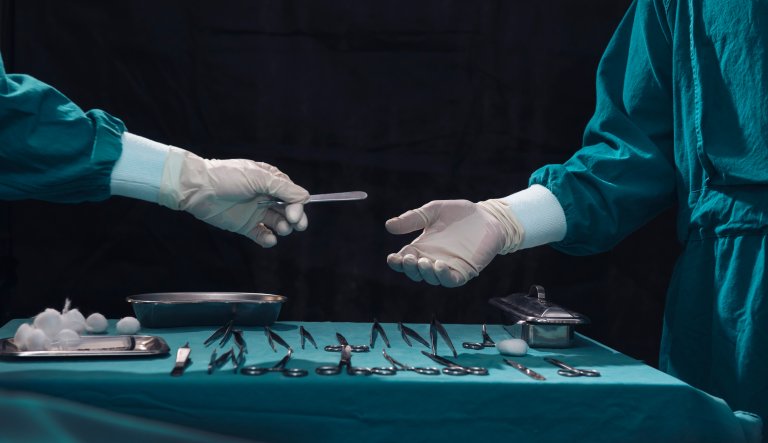It has been established that the scientific burden of proof (evidence) associated with the taTME method was deficient, both at the time when the first hospital started up in 2014, and later via FHI’s literature review (2019). The taTME method must therefore be considered to be a trial treatment.
The white paper Meld. St. 10 (2012–2013) Good Quality – Safe Services – Quality and Patient Safety in the Health and Care Service, the term trial treatment was used about “all treatment where efficacy, risks and adverse reactions are not sufficiently documented for the treatment to be included in the ordinary treatment provision. This means that trial treatment concerns both treatment subject to clinical trials and undocumented treatment given outside clinical trials.” It is furthermore stated that the rapid developments in medical technology in recent times, such as keyhole surgery, have contributed to more effective and less invasive treatment for patients. However, it is a major challenge for both the health service and health authorities that these new methods are implemented without sufficient documentation of the method’s safety, or adequate testing in clinical trials. The report also highlights the variation in practice in terms of how the health service adopts new methods, both between hospitals in the same region, and between regions. There is too little awareness of the divide between standard treatment, and what should be considered to be development work. Within surgery, there has been a tradition of developing the profession to ensure patients access to ever better treatment options. This has usually functioned well for minor adjustments to established methods. For wider adjustments, this approach presents greater risk to the patient, because the patient may then be offered treatment that is neither approved nor safe enough. The fact that new methods are adopted following local initiatives also contributes to the failure of the health authorities to have sufficient oversight of the types of treatment options offered at the individual hospitals. The white paper Meld. St. 10 (2012–2013) also describes a need for a national method assessment system, as well as national principles for trial treatments, to ensure the development of safe treatment methods for patients (32). A national guideline with principles for trial treatment was published by the Norwegian Directorate of Health in November 2019. In the guide, there is a precise definition of trial treatment:
“Trial treatment is any treatment of which the efficacy and safety are not sufficiently documented for the treatment to be included in the normal treatment provision. This means that trial treatment concerns both treatment subject to clinical trials and treatment given outside clinical trials.” (33).
There are several examples up through history of how new surgical and invasive procedures have led to unexpected or serious consequences for patients after implementation (28). Examples of invasive methods that have been temporarily or permanently suspended after they were taken into use in Norway include TAVI (catheter-based implantation of heart valves in patients with aortic valve narrowing) and Essure (new sterilisation method for women), see Appendix 2.
Introduction of TME in Norway as a national project
During the 1980s, reports were published from individual departments in England showing good treatment outcomes with fewer local recurrences (relapses) for rectal cancer using the TME operating technique (22). In Norway too, TME was taken into use at individual departments in Norwegian hospitals, with good results (34). This gave reason to believe that the TME method could improve rectal cancer survival rates. There were gradually also reports that rectal cancer surgery should be performed by fewer, specialist surgeons who were specially trained in the method. In order to assess whether these measures worked, a national registry for rectal cancer was needed. In Norway, the introduction of the TME surgical method in 1993 was organised as a national project (the Rectal Cancer Project), and a number of courses were arranged for the training of surgeons in Norway. In this way, hospitals could compare themselves with a national average, correct their own practice and ensure the necessary quality improvement. Pathologists also received training aimed at a quality improvement in and standardisation of the descriptions of the pathological samples, so that these could also be evaluated. An evaluation of the introduction of TME in Norway in the 1993-1999 period showed that surgery using the TME technique reduced the frequency of local recurrences (relapses) from 28 per cent to 8 per cent, while the five-year survival rate increased from 55 per cent to 71 per cent for patients under 75 years of age (22). In order to monitor patients with rectal cancer who had received TME treatment, in collaboration with the Cancer Registry a quality registry for rectal cancer was created in 1996. In addition to registering data relating to the use of TME, there was also prospective registration of rectal cancer in Norway.
Registration of colon cancer was included in this registry as from 2008, and the registry gained the status of official National Quality Registry for Colorectal Cancer (1).
How taTME was implemented in hospitals
In our investigation, we have seen that there was no equivalent national coordination of the start-up of taTME surgery. The method was used in Norway for the first time in 2014, at a local hospital without any kind of protocol. Common to all seven hospitals that began to perform taTME surgery was that the decision to start up was taken at department level after assessment by the local gastrointestinal surgical community at the hospital. TaTME was implemented by hospitals in three out of four regional health authorities in Norway. At this time, taTME was not mentioned in the National Action Programme with Guidelines for Diagnostics, Treatment and Follow-up of Colorectal Cancer. Nor was taTME registered for method assessment in the National System for Managed Introduction of New Health Technologies (New Methods).

NHIB has obtained information from the gastrointestinal surgical departments of all hospitals that implemented the method. The information we have received shows that it is common practice for the trial of new surgical methods to be decided at department or clinic level. Locally managed trials of new methods has been a tradition within surgery. Today it is most often the case that new methods are introduced as a local initiative, by the individual surgeon on the basis of their own special interests. This is how surgical innovation has been promoted. This constitutes a completely different tradition to the introduction of new drugs, which without exception takes place through trials in research projects.
The hospitals responded that, in connection with the trial of taTME, training and guidance were provided for the participating surgeons. The training varied, with some surgeons receiving training abroad via courses in Spain, the UK, the Netherlands or Belgium. Some hospitals also used Norwegian or foreign proctors (supervisors), but three of the seven hospitals stated that they did not use any such proctor scheme when they started using taTME. There was no standardised strategy for training Norwegian gastrointestinal surgeons before the method was adopted. The professional communities at the respective hospitals decided for themselves how the training would be conducted for their own surgeons.
Only one of the hospitals in our investigation stated that they undertook taTME as part of a clinical trial. The other hospitals had no ongoing trials at the time of adopting taTME, even though three of the hospitals adopted the method after 2017. The recommendation in the National Action Programme for Colorectal Cancer was that taTME should only be used within the framework of prospective clinical trials, with thorough information for participating patients, in order to gain greater knowledge of outcomes. It was also in this edition of the 2017 Action Programme that taTME was mentioned for the first time. The hospitals that started to use the method, without a clinical trial, stated as a reason that the method was perceived as sufficiently well-documented.
The hospitals believed it was sufficient to monitor patient data in local quality registries.
As the timeline shows, we can see that revising and updating the national guidelines for treatment of colorectal cancer was a protracted process. The Norwegian Directorate of Health has informed NHIB that the national action programmes in the cancer field are now updated and revised regularly and as required, and at least once every year.
In the guidelines published in England by the National Institute for Health Care and Excellence (NICE) in March 2015 regarding taTME, it was stated that the current evidence regarding the safety and efficacy of the method was limited, in terms of both quantity and quality (35). The guidelines therefore required surgeons who wanted to try the method to inform the senior management of this, and also that the patients in question had to be informed in detail and in writing of the uncertainty associated with the procedure. Furthermore, the guidelines required the introduction of the method to be followed up, either with surveillance (monitoring) or research, in order to control patient outcomes (35).
As we have seen in this investigation, no nationally formalised cooperation was established to trial the taTME method in Norway. Nor was a taTME registry created, which would have made it possible to aggregate the results of all seven hospitals and quality assure the results of the method in Norway. A national overview, in the form of a scientific audit, was not in place until the autumn of 2018. This took place after the first notifications of concern had become known in the spring of 2018. So it took around four years from the first hospitals adopting the method until the work commenced of gaining an overview of the outcomes of the taTME procedures carried out in Norway.
In our investigation, three hospitals responded that they fully or partly registered their patient data in the international taTME registry, International taTME educational collaborative (36). One hospital submitted an application to the Regional Committees for Medical and Health Research Ethics (REK) in Norway for assessment and approval of the submission of patient data to this international multicentre study (LOREC). However, this application was submitted in February 2019, long after the hospital had submitted data to the English taTME registry, LOREC. The hospital has informed NHIB that it submitted data from the ordinary patient records, including demographic, tumour-related, intra- and postoperative data (gender, date of birth, date of surgery, preoperative diagnostics with MR and ultrasound, intraoperative data such as blood loss and operation time, and postoperative data such as length of stay on the ward and complications, as well as long-term follow-up). REK assessed that the application concerned quality assurance of treatment provision that already was established, and concluded that the project therefore fell outside the scope of the Norwegian Health Research Act with approval requirements. The other hospitals had no contact with REK in connection with the use of the method. One of the hospitals received an assessment from the local data protection officer (DPO), who concluded that there was no need for REK’s approval. None of the other six hospitals stated that they approached their local data protection officer for an assessment.
Introduction of new surgical methods as a trial compared to new drugs in National System for Managed Introduction of New Health Technologies (New Methods)
The introduction of taTME in Norway illustrates how surgical interventions have traditionally been adopted and the challenges this presents, compared to, for example, the introduction of new drug therapy.
In 2013, a national scheme for the introduction of new drugs and methods was established, called the National System for Managed Introduction of New Health Technologies within the Specialist Health Service in Norway, now New Methods. The regional health authorities are responsible for New Methods. This scheme has mainly been used for the introduction of new drugs, and to a small extent for the introduction of new surgical methods, as the majority of the cases reported for consideration by New Methods relate to drugs (37).
In 2020, a total of 142 proposals and method alerts were reported for assessment in New Methods, distributed as 121 methods for pharmaceutical drugs, 10 methods for medical devices, diagnostics and tests, and 11 methods for procedures and organisational measures (37). From the establishment of the New Methods system in 2013 and up to 2020, a total of 769 proposals and method alerts were submitted for assessment. These comprise 597 methods for drugs and 173 methods for non-medicinal products (such as medical devices, medical and surgical procedures and diagnostic tests) (37).
The fact that assessment of surgical methods is in the minority may be due to several factors. One reason may be that the development of new surgical methods and other non-medicinal methods cannot always take the same course as for the development and introduction of new drugs with randomised trials (38). It is more difficult to conduct randomised trials for surgical methods than for new drugs (38, 39). It is also possible that fewer new surgical methods are actually developed, compared to medicinal products, but this is difficult to quantify.
The introduction of the taTME method in Norway is a good example of challenges related to the introduction and implementation of new surgical techniques, compared to the introduction of new medical products. When introducing new drugs, there are strict rules and requirements for testing in clinical trials before the drug can be approved for clinical use. For new surgical methods, there is no equivalent tradition of adhering to regulations or requirements prior to implementation (28).
For example, the existing TME method was gradually adopted as the standard surgical treatment for rectal cancer, based on observational studies rather than randomised, controlled trials (28). TME subsequently proved to be a method that reduced local recurrence of rectal cancer, both in Norway and internationally.
The learning curve on the introduction of new methods
Another challenge associated with surgical innovation is learning curves. The introduction of a new surgical method requires the surgeons to receive training before they can perform the procedure independently in a responsible way (28). This means that there is a learning period during which the individual surgeon has limited experience from using the method, and where there is a greater risk of adverse outcomes. Nevertheless, it is not acceptable for the learning curve period to affect the safety of patients (7). If there is a risk of patient injury, compensatory measures must be taken in advance.
On the trial of taTMe in Norway, there was great variation in training and guidance (proctor scheme) at the seven hospitals. Some members of the Norwegian gastrointestinal surgical community state that the learning curve was of less significance on the introduction of taTME in Norway. The reason given is that the local recurrences occurred not only after the earliest treatments performed, but also after experienced surgeons had used the method at several of the hospitals (6, 7). The learning curve is nevertheless referred to internationally as an important factor to take into account when using this method (43).

Mini-method assessment for new treatment methods
A mini-method assessment is a simplified assessment that can be used by hospitals before a new treatment method is adopted. Mini-method assessment includes a literature search and critical assessment of research literature on the method, with main emphasis on efficacy and safety. In addition, the organisational, economic and ethical implications of introducing the method (44) are assessed.
The Norwegian Institute of Public Health (FHI) is the national resource group for mini-method assessments, and competence resources have been established in all of the four regional health authorities, to assist the clinical professional community with the preparation of these assessments. On FHI's website it is stated (in Norwegian) that
“Mini-method assessments reveal the consequences of introducing new methods at hospitals, contribute to knowledge-based and transparent decisions, and help to increase patient safety” (45).
FHI also operates the national database for mini-method assessments with an overview of commenced and approved mini-method assessments. In the database of completed mini-method assessments, methods approved in 2020 and 2021 show that Oslo University Hospital is responsible for almost all of these assessments (46).
When trying out new surgical methods, the fact that there will be limited access to randomised trials represents a challenge. A mini-method assessment may nevertheless, in some cases, be a useful tool for raising awareness of the basis of evidence concerning a new method.
In connection with the introduction of taTME, only one hospital responded that they undertook a mini-method assessment. However, this was performed after the procedure had been introduced and was related to the need for resources for the necessary equipment.
The Intervention Centre at Oslo University Hospital HF as a national resource
The Intervention Centre at Oslo University Hospital HF (OUS) was established by the Storting in 1996 as a common, national resource. The Intervention Centre is a provider for all entities in the health service concerning:
- Development of new treatment methods
- Development of new treatment strategies
- Comparison of new and established methods
- Studies of the social, economic and organisational consequences of new methods.
Training of healthcare professionals in new treatment methods is an integral aspect of this (47). When the Intervention Centre collaborates with clinical communities on the development of new methods, trials created must show what needs to be documented in order to introduce the method in the clinic.
In our interviews, we received feedback that the Intervention Centre’s provision is little known in the gastrointestinal surgical professional community with which we were in contact in conjunction with this investigation.
